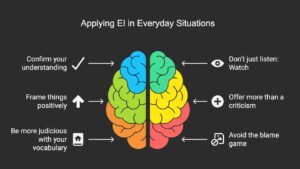What is emotional intelligence?
Scientists Mayer and Salovey defined the emotional intelligence model as “strategic” (rather than “experiential”) intelligence. Understanding emotions, is the ability to comprehend information about relations between emotions, transitions from one emotion to another, and to label emotions using emotion words. A person who is good at understanding emotions would have the ability to see differences between related emotions, such as between pride and joy. The same individual would also be able to recognize, for instance, that irritation can lead to rage if left unattended.

According to another definition, emotional intelligence is the ability to manage one’s emotions as well as the emotions of others. This skill of managing emotions is perhaps the most commonly identified aspect of emotional intelligence. Emotional intelligence is far more than simply being able to regulate bad moods effectively. It can also be important to maintain negative emotions when needed. For example, a speaker trying to persuade her audience of some injustice should have the ability to use her own outrage to stir others to action.
Putting words (emotional intelligence) into practical use in everyday life, emotional intelligence can help to navigate following challenges:
- Emotional intelligence may help one get along with peers and supervisors at work.
- Emotional intelligence may also be important for creating and sustaining good relationships with peers.
- Emotional intelligence may also help people more successfully navigate personal relationships.
But how can we best apply EI to work communications, whether providing feedback to an employee, attempting to get buy-in for a new idea, or working through a misunderstanding. And how can we make sure to use it in your everyday conversations?
Ways of applying EI in everyday situations:
1. Confirm your understanding
In situations when emotions are running high, it’s easier to get confused or misunderstand. We may start off by saying “So am I right in thinking …” or “Can I clarify what I’ve heard” or “Can I just be clear…” before repeating back your understanding of what has been said.
2. Don’t just listen: Watch
Pay attention to both verbal and non-verbal communication. If someone says they get what you’ve told them but their face or shoulders say something else, follow up to find out what is going on. You might say, for example, “You said you understood, but you look unsure. Can you tell me what you’re feeling about it?”
3. Frame things positively
When things are going wrong with a piece of work, discuss what qualities and strengths [an employee or team] have that will help solve problems and contribute to overcoming difficulties. “If we can support people and encourage them when things are difficult, we’ll be inspiring them to see the best in themselves and the situation.”
4. Offer more than a criticism
When we need to offer criticism, take a moment. Before we say anything, decide what, exactly, the other person has done that’s a problem for you. “You’re the one with the problem. What is the solution?” Then decide what change or improvement you want to see. Instead of saying something was done wrong or was not wanted, instead say, “There are a few aspects of this project I’d like you to go back over,” and then explain what those things are.
5. Be more judicious with your vocabulary
“The right words make the difference”. Instead of using words like “incompetent” or “wrong,” we can explain that a colleague or employee “could be more careful” and then explain how. Alternatively, we can say, “It would be good if you could…” or “One thing that might help is…” to give the communication a more positive spin.
6. Avoid the blame game
Blame is a surefire way to get someone to shut down or become defensive. One way to avoid this: Start replacing “You” statements with “I” statements. Instead of saying “You need to…” say “I’d like you to…”. “Don’t be afraid to tell the other person how you feel.” You might say, “I was upset or embarrassed when…” and describe what bothered you. “But try to avoid speaking in a tone that’s sarcastic, hostile, or condescending,” says Hasson. “Speak in a calm neutral way. This can make a big difference.”

Conclusion:
Applying these ways of emotional intelligence in everyday situations helps you connect better with others by showing genuine understanding, and it allows you to show empathy by noticing both words and emotions. It creates a space where people feel safe to share without judgment, which in turn improves the working environment by reducing conflicts and building trust. Positive framing and respectful communication support a healthier work-life balance, lowering stress levels. Altogether, these practices help individuals and teams feel happier, increase workplace satisfaction, and can even decrease layoffs.




